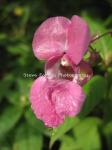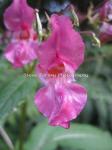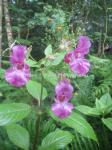Himalayan Balsam
Impatiens glandulifera
A regular visitor to Brayton Barff, Himalayan Balsam is a relative of the busy Lizzie. It can reach heights of over eight foot and is a major invasive weed problem. It can be found along riverbanks, railway sidings and waste ground. The plant was introduced into the country in 1839 and has now become a naturalised plant. It tolerates low light levels so thrives on the woodland of the Barff, its size means that it shades out other vegetation.
Himalayan Balsam is a tall growing annual, it flowers between June and October when it produces clusters of purplish pink helmet shaped flowers. The flowers are followed by seed pods that explode open when ripe. Each plant can produce 800 seeds which are dispersed widely as the ripe seedpods shoot their seeds up to 22 ft away.
Plants that out compete other more desirable plants or invade half the garden are classed as weeds which require control. On the Barff they are controlled chemically, though the main non chemical method is to pull the plants before they flower and set seed. Conservation groups often arrange ‘balsam bashing’ working parties to clear the weed.
|

















